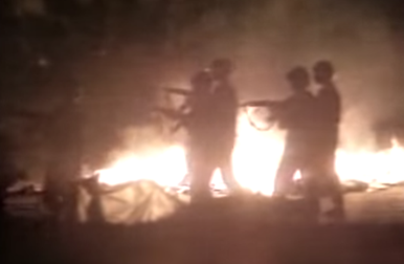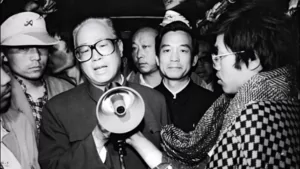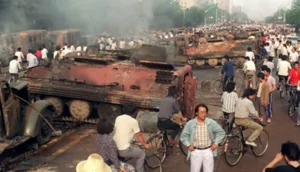
The Tiananmen Massacre Remembered at 30 Years: The Chinese Communist Party’s Political and Military Considerations
Publication: China Brief Volume: 19 Issue: 11
By:

Introduction—Divisions Within the Communist Party Set the Stage for Tiananmen
We don’t know how many demonstrators or ordinary citizens were killed during the Tiananmen Massacre, but it was bloody and brutal. After June 4, 1989, the CCP set the death toll at 200—of which it claimed that only 36 were students, and that 23 members of the People’s Liberation Army (PLA) or People’s Armed Police (PAP) were killed. [1] A discreet source of information affiliated with the Chinese Red Cross, a doctor, told the U.S. Embassy on June 4, 1989 that the death toll was around 2,600. [2] Even after the violence on the night of June 3-4, the streets of Beijing were filled with sporadic gunfire from the PLA for days after that. [3]
One reason for the violence was an extended period of internal debate and inaction by the leadership of the Chinese Communist Party (CCP) as the protests spread throughout China in the spring of 1989. The length and size of the protests in China, and the ultimate scale of the violence, resulted in part from an inability to reach decisions on handling the protests by the Communist Party’s Politburo Standing Committee (PBSC). [4]
The CCP leadership had been in disagreement over the pace of economic and political reform in China for some time. After an extended period of student demonstrations in 1986, CCP General Secretary Hu Yaobang was criticized for his handling of events. Hu, along with a group of CCP Leaders (Zhao Ziyang, Lu Dingyi, Wan Li and Xi Zhongxun), had argued that economic reform should proceed in parallel with Party political reforms, including an expanded role for labor unions. [5] Hu’s main critics in the CCP were a group of Party elders and conservatives: Li Xiannian, Chen Yun, Li Peng, Deng Liqun, Wang Zhen, Hu Qiaomu, Peng Zhen, Bo Yibo, Yu Qili and Yang Shangkun. In 1987, Hu was dismissed from office and replaced as General Secretary of the CCP by Zhao Ziyang. Hu Yaobang’s critics eventually formed the core group of “conservatives” (a CCP group of more orthodox Maoist, Marxist-Leninist Party members) who determined the ultimate course of events during the Tiananmen demonstrations and massacre. [6]
Events in Spring 1989 Leading to the Massacre
There was a long period of demonstrations around China in spring 1989, which began with the death of Hu Yaobang on April 15, 1989. That day, flags were flown at half-mast. At universities around Beijing, large-character posters were displayed by students with slogans like: “A Great Loss of Democracy and Freedom,” and “The Star of Hopes Has Fallen.” By the next day, April 16, several hundred people placed wreaths honoring Hu at the Monument of the People’s Heroes in Tiananmen Square. On April 17, students and teachers from Beijing universities gathered on Tiananmen Square shouting “Long live democracy, down with corruption, and down with bureaucracy.” [7]
Students also sent a letter to the Standing Committee of the National People’s Congress demanding a reappraisal of Hu Yaobang and his career. At this point, the Public Security Bureau was able to control the crowd. [8] Hu Yaobang’s funeral was April 22, which led to larger demonstrations and marches around the city involving students, workers, government employees, and even some military personnel. [9] Demonstrations involving tens to hundreds of thousands of people continued in Beijing through April 25. Meanwhile in Hunan Province, demonstrators were detained and arrested after rioting in the provincial capital of Changsha.
At the time the demonstrations began the members of the PBSC were Zhao Ziyang, Li Peng, Qiao Shi, Hu Qili, and Yao Yilin (People’s Daily, November 2, 1987). However, despite their high office, these men did not have as much authority as their titles implied. A group of Party elders, many of them veterans of the CCP since its formation, were part of a Central Advisory Commission that influenced debates on how to respond to the demonstrations. [10] Further complicating matters, it was the Party Central Military Commission (Zhongguo Gongchandang Zhongyang Junshi Weiyuanhui, 中国共产党中央军事委员会) that formulated military policy and had the authority to give orders to the PLA. To summarize the situation as the demonstrations developed around Beijing: the Party leadership was in disarray and in disagreement about establishing martial law, as well as divided over how to respond to the general unrest, and whether to call in the PLA. [11]
After Hu Yaobang’s funeral, demonstrations continued around Beijing through the rest of April, with discussions going on at the highest levels of the CCP about whether to respond, and how to respond. Li Peng and the Propaganda Department began to call the demonstrations a form of “turmoil.” [12] Generally, however, the environment was permissive and the PAP and Public Security Bureau worked to create avenues for the marchers while still keeping traffic flowing around the city.
The April 26 Editorial and Hardening Attitudes Among Party Elders
Things changed on April 26, 1989. That morning People’s Daily published a front-page, italicized editorial entitled “The Necessity of Taking a Clear-Cut Stance Against Disturbances.” [13] The Defense Attaché Office in the U.S. Embassy began to get reports from former military personnel traveling into the city that their trains had been diverted so that military rail convoys could use the tracks. At the same time, students in universities claimed that as many as twenty thousand troops had been deployed to Beijing by the PLA 38th Group Army stationed south of Beijing in Hebei. Military units were reminded to “trust the Central Military Commission (CMC)” and not to deploy troops unless approved by the CMC. [14]
Li Peng and Zhao Ziyang, now CCP General Secretary and CMC First Vice-Chairman, split on how to respond to the demonstrations. Zhao did not want to crack down hard on the demonstrators. Inside the CMC, with Deng Xiaoping as chairman, conservative, hardline military veterans like Yang Shangkun, his brother Yang Baibing, Liu Huaqing, and Hong Xuezhi also differed with Zhao on how to handle the situation. [15] Thus, there were civil-military disagreements at the top levels of both the Party and the military.
During May, a few major events catalyzed the matter for the Party leadership, which led to a complete split between reform-minded Party leaders and conservatives, and brought about the dismissal of Zhao Ziyang as General Secretary (The Washington Post, May 15, 2009). Zhao was sympathetic to the protestors, who wanted the April 26 People’s Daily article retracted. On May 13, the students in the square began a hunger strike and refused to leave Tiananmen Square—which increased the loss of face for the government, as a visit to the Great Hall of the People by Soviet President Michael Gorbachev was imminent (Chicago Tribune, May 14, 1989). At first, the Politburo endorsed the moderate approach to the students advocated by Zhao: for example, during Gorbachev’s visit, an estimated 150,000 students and spectators gathered in the Square, making access to the Great Hall of the People difficult, but PSB and PAP guards created access corridors for vehicles. [16]
By May 17, there were more than a million people around Tiananmen Square, including students, intellectuals, workers and some government employees and military organizations. [17] Then on May 19, senior CCP leaders Li Peng, Yan Mingfu, and Li Tieying met with the student leaders. [18] Wuer Kaixi, one of the student leaders, demanded that the April 26 editorial be retracted, interrupting Li Peng several times. Li Peng asserted that the student’s actions had “stirred up turmoil.” [19]
Later, on May 17, Zhao Ziyang was summoned to a meeting with Deng Xiaoping. However, instead of a one-to-one discussion, Zhao was meeting with the entire PBSC. Zhao tried to have the April 26 editorial modified as an attempt to ease tensions with the students, but President and CMC member Yang Shangkun argued that martial law should be declared. Ultimately, Deng Xiaoping called for a vote by the Politburo on repealing the editorial, resulting in a sixteen to two vote in favor of calling the student movement a “riot.” Zhao Ziyang then submitted his resignation as CCP General Secretary. [20]

The Declaration of Martial Law and Deployment of Troops in Beijing
On May 20, 1989, early in the morning, Li Peng signed the “Order of the State Council of the People’s Republic of China on the Implementation of Martial Law in Parts of Beijing.” [21] The units identified in the initial deployment were from the following PLA Group Armies: 24th, 27th, 28th, 38th, 39th, 40th, 54th, 63th, 65th, 67th, Beijing Garrison Command, 15th Airborne Army of the PLA Air Force, and 6th Tank Division. [22] Around dusk on May 20, PLA units attempted to enter the city from all directions; however, they were blocked by residents supporting the students. Along Fuxing Road, near Muxidi on the west side of Beijing, an entire convoy—likely from the 38th Group Army—was stopped by residents. The confrontation was peaceful, with residents speaking to soldiers and the unit taking no action to move further into the city. [23] The situation was confused, but it was clear that even local Party branches were unhappy with the martial law declaration and the movement of troops into the city.
There also was confusion in the United States. Many in the U.S. intelligence community and academia accepted the logic of a number of commentators sympathetic to the Chinese government that the CCP would not use the PLA against the Chinese people. Others in government and the intelligence community also failed to understand the dangerous situation developing in China. However, throughout this time U.S. military attaches had been keeping up a regular stream of reporting, along with their NATO allies. [24]

Following the peaceful popular resistance that frustrated the initial attempts to impose martial law, PLA troops were pulled back to assembly areas on military bases, in factories, and in parks within minutes to an hour of striking distance into the city. [25] The commander of the 38th Group Army, Xu Qinxian, checked into a hospital rather than obey the martial law order. He was subsequently relieved of command. [26] Meanwhile the CMC ordered stronger Party indoctrination for the troops in the assembly areas. The PLA began inserting reconnaissance elements into the city while residents created barricades with city buses and bulldozers.
On June 3, there was a final attempt by the CMC to move troops to Tiananmen Square peacefully. At dawn that morning, from the east along Chang An Road, “a regiment of the 196th Infantry Division from Tianjin attempted to enter Tiananmen Square unarmed. They were turned back at the second ring road by citizens and students.” [27] Things went downhill fast after that. Troops moved into assault positions early in the morning on June 4 and the assault on Beijing by the PLA began. Even here, after two weeks of political indoctrination, the civil-military split was evident: one unit reported by British military attachés as coming from the 28th Group Army turned weapons over to demonstrators, and their armored personnel carriers and trucks were burned by the crowd. [28]
Conclusions
Today, the CCP leadership would prefer not to use the PLA again in case of riots or unrest. They have strengthened and enlarged the People’s Armed Police and created PAP and PSB riot units. But if the Party center felt threatened again, it is unlikely that Xi Jinping would vacillate and debate: he would not hesitate to crush widespread unrest. The CCP leadership remains as determined as ever to maintain their ruling position, and armed force remains the ultimate guarantor of the Party’s grip on power.
Larry Wortzel is a veteran Asia scholar, who served two tours of duty as a military attaché in the American Embassy in China—including during the Tiananmen Massacre of 1989. Since retirement from the U.S. Army, Dr. Wortzel has served as director of the Asian Studies Center at The Heritage Foundation, and as a longstanding member of the U.S.-China Economic and Security Review Commission. He is also a member of the Council on Foreign Relations and the International Institute of Strategic Studies.
Notes
[1] Larry M. Wortzel, “The Tiananmen Massacre Reappraised: Public Protest, Urban Warfare, and the People’s Liberation Army,” in Andrew Scobell and Larry M. Wortzel, Chinese National Security Decisionmaking under Stress (Carlisle, PA: Strategic Studies Institute, 2005), pp. 76-77.
[2] Author Louisa Lim quotes the Swiss ambassador saying that 2,700 died in Beijing; however, Lim notes that elsewhere in China, particularly in Chengdu where there were major demonstrations, as many as 300 people also died. See: Louisa Lim, The People’s Republic of Amnesia: Tiananmen Revisited (London: Oxford University Press, 2014), pp. 7, 196-197.
[3] James Lilley with Jeffrey Lilley, China Hands: Nine Decades of Adventures, Espionage, and Diplomacy in Asia (NY: Public Affairs, 2004), pp. 324-338; Ezra F. Vogel, Deng Xiaoping and the Transformation of China (Cambridge, MA: Belknap Press, 2011), p. pp. 616-643; Theodore Han and John Li, Tiananmen Square Spring 1989: A Chronology of the Chinese Democracy Movement (Berkeley, CA: Institute of East Asian Studies, 1992), PP. 59-83.
[4] The Standing Committee of the Central Political Bureau of the Communist Party of China, or Politburo Standing Committee (PBSC), is the highest-ranking policy-making organization in the CCP. On the internal squabbles, see Zhang Liang, compiler; Andrew J. Nathan and Perry Link, eds., The Tiananmen Papers: The Chinese Leadership’s Decision to Use Force Against Their Own People-In Their Own Words (New York: Public Affairs, 2001), pp. 52-97, 238-385.
[5] Zhang, Nathan and Link., The Tiananmen Papers, pp. 4, 14; Vogel, Deng Xiaoping and the Transformation of China, pp. 577-580.
[6] Ibid. on the events and their linkages to reform see also James A. Dorn and Wang Xi, Economic Reform in China: Problems and Prospects (Chicago: University of Chicago Press, 1989).
[7] Han and Li, Tiananmen Square Spring 1989: A Chronology of the Chinese Democracy Movement, p. 5-6.
[8] Ibid. p. 7.
[9] The two best daily chronologies are in Han and Li, Tiananmen Square Spring 1989: A Chronology of the Chinese Democracy Movement and Zhang, Nathan and Link, The Tiananmen Papers, pp. 4, 14; Vogel, Deng Xiaoping and the Transformation of China. Another superb resource is Jian Ding, Elaine Yee-Man Chan, and Leslie Evans, The China Democracy Movement and Tiananmen Incident: Annotated Catalog of the UCLA Archives, 1989-1993 (Los Angeles: University of California Los Angeles, April 1, 1999). The author has had the opportunity to go through the UCLA archives and in addition to having observed the events as a military attaché in China relies on his notes from the UCLA archive.
[10] William A. Joseph, Politics in China an Introduction (Oxford: Oxford University Press, 2010), p. 112. See also, ‘Eight Elders,‘ Ihttps://www.revolvy.com/page/Central-Advisory-Commission
[11] Defense Intelligence Agency DIADIN 141-1B, China Situation Report, 21 May 1989, declassified in part per Executive Order 13526, 2000-0950-F/3, 11/2/10, Document 221 in the archives of the George H.W. Bush Presidential Library, College Station, TX.
[12] Zhang, Nathan and Link, The Tiananmen Papers, pp. 76-77.
[13] Han and Li, Tiananmen Square Spring 1989: A Chronology of the Chinese Democracy Movement, p. 15.
[14] Zhang, Nathan and Link, The Tiananmen Papers, p. 79.
[15] Ibid. Vogel, Deng Xiaoping and the Transformation of China, pp. 604-608.
[16] Han and Li, Tiananmen Square Spring 1989: A Chronology of the Chinese Democracy Movement, pp. 25-33.
[17] Ibid. p. 33; author’s recollections from notes.
[18] Li Peng was one of the conservatives and was a PBSC member and Premier of China. Yan Mingfu was director of the CCP United Front Work Department and Secretary of the Politburo. Li Tieying was a Central Committee member and State Education Minister. Yan Mingfu was subsequently dismissed from his posts by the Party in late June. See Wortzel, “The Tiananmen Massacre Reappraised: Public Protest, Urban Warfare, and the People’s Liberation Army,” p. pp. 63-65.
[19] Han and Li, Tiananmen Square Spring 1989: A Chronology of the Chinese Democracy Movement, pp. 34-35.
[20] Ibid. p. 36; Zhang, Nathan and Link, The Tiananmen Papers, p. 223-232.
[21] Zhang, Nathan and Link, The Tiananmen Papers, p. 233.
[22] Wortzel, “The Tiananmen Massacre Reappraised: Public Protest, Urban Warfare, and the People’s Liberation Army,” p. pp. 72-73.
[23] The author and the U.S. Air Attaché to China witnessed this event.
[24] See Wortzel, “The Tiananmen Massacre Reappraised: Public Protest, Urban Warfare, and the People’s Liberation Army,” passim; Lilley with Lilley, China Hands: Nine Decades of Adventures, Espionage, and Diplomacy in Asia, pp. 296-334; Defense Intelligence Agency DIADIN 141-1B, China Situation Report, 21 May 1989.
[25] Defense Intelligence Agency DIADIN 141-1B, China Situation Report, 21 May 1989, declassified in part per Executive Order 13526, 2000-0950-F/3, 11/2/10, Document 221 in the archives of the George H.W. Bush Presidential Library, College Station, TX.
[26] Zhang, Nathan and Link, The Tiananmen Papers, p. 239.
[27] Wortzel, “The Tiananmen Massacre Reappraised: Public Protest, Urban Warfare, and the People’s Liberation Army,” p. 74.
[28] Author’s notes and recollections.



